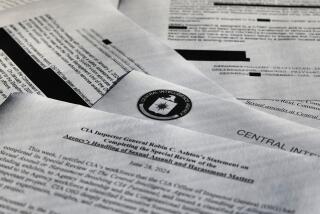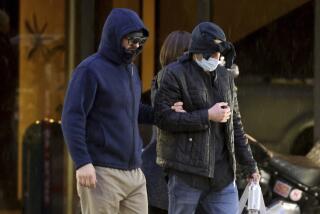CIA, North Network Had Close Ties, New Data Hints
- Share via
WASHINGTON — New evidence in the Iran-Contra affair indicates that some senior CIA officials, whose involvement in secret arms sales to Iran and Nicaraguan rebels had already been revealed, also played significant roles in the private military and espionage network run by former White House aide Oliver L. North and his associates.
The evidence, much of it compiled by the congressional Iran-Contra committees but never released, involves participation by CIA officials in efforts to obtain a high-tech Soviet tank from Iran and to divert grenades and grenade launchers from a CIA-bound arms shipment.
Other disclosures suggest that senior agency officials monitored a ship purchased by North’s network to perform such covert missions as arms smuggling and hostage rescues. CIA officials identified by sources as involved in the operation include Central America Task Force chief Alan D. Fiers Jr. and European operations head Duane (Dewey) Clarridge, both of whom have been reprimanded for their roles in the scandal.
The missions were undertaken by the so-called Enterprise, the network directed by North and three private-sector associates, Albert A. Hakim, Richard V. Secord and Thomas C. Clines.
North described the Enterprise to the congressional Iran-Contra committees last summer as an “off-the-shelf, self-sustaining, stand-alone entity” exempt from government oversight and designed to carry out missions that its chiefs felt might not otherwise be approved.
A CIA spokeswoman declined comment on the disclosures of CIA involvement in the Enterprise. “We wouldn’t confirm or deny allegations of intelligence activities, which is our standard response” to press inquiries, the spokeswoman said.
William H. Webster, who took over as CIA director in May, after the Iran-Contra affair had run its course, closed his agency’s books on the affair three weeks ago when he fired or punished six employees. His action followed an internal review of CIA officials’ involvement in illegal or unauthorized activities.
Agency Portrayal in Doubt
The new disclosures, however, cast shadows over the agency’s portrayal of itself as a bit player in the biggest political scandal of the decade. The CIA maintained as recently as last January that its employees took no part in any of North’s unauthorized operations, only to admit later to improprieties--first in Costa Rica, then Honduras, and this month in its Washington headquarters.
Experts who have seen or been told about the new material say it suggests a working knowledge of the Enterprise by some agency officials, to the point where CIA agents in Denmark filed eyes-only reports on some of the network’s European operations to the CIA’s suburban Washington headquarters.
“Look, fellas,” said one former government official familiar with the evidence, “I do believe the agency was in on this thing from the beginning. I think that Hakim, Clines, all these guys were reporting to the agency on a regular basis.”
Among those interviewed for this article were persons who worked with the Enterprise, as well as congressional officials and intelligence experts familiar with the new evidence on the CIA’s ties to North.
Some Leads Not Pursued
Some of the new evidence was compiled by the Iran-Contra committees in the final weeks of their 10-month probe and relayed to the House and Senate intelligence committees and to Webster, knowledgeable sources say. Other disclosures, however, were not pursued or made public because of time pressures and a lack of political interest.
Although North has testified that the Enterprise was the brainchild of the late CIA Director William J. Casey, sources say the disclosures do not imply that the CIA’s entire top management approved North’s network. Instead, the evidence suggests disputes within CIA ranks over the wisdom of dealing with key Enterprise figures.
An internal review of the agency’s conduct during the scandal concluded that some top CIA officials, apparently including Fiers and Clarridge, had been “less than candid” about their knowledge of the affair.
An unclassified six-page summary of the review, which led Webster to fire two Central America undercover agents and discipline Fiers, Clarridge and two others, appeared to clear those officials of any direct role in potentially improper activity in the Enterprise. But evidence collected by congressional investigators and others this autumn suggests that conclusion could be premature.
Describes Bizarre Project
The new material describes a bizarre project engineered by North and Fiers to secretly divert part of a 358-ton shipload of weapons that the CIA had purchased from the Enterprise in September, 1986.
Entries in North’s office diaries, not yet made public, outline two telephone discussions between North and Fiers over the diversion, which apparently occurred that October at a North Carolina military pier shortly before the CIA shipment was unloaded at a second, nearby military terminal.
Taken from the Danish ship Iceland Saga was a small number of Polish-made rocket-propelled grenades and grenade launchers, the basic anti-tank weapon of Soviet-bloc nations and a staple of CIA-backed guerrilla forces in Nicaragua, Afghanistan and Angola. However, CIA warehouses hold “oodles” of the weapons which could have been readily shipped to the Contras or others, one U.S. official noted.
“The only reason to go outside (the agency) is for something that you don’t want the agency to know about,” that official said. “You have to wonder: If you don’t want the agency to know, then what kind of use were they intended for?”
North Not Questioned
Investigators do not know. North was not asked about the operation during last summer’s hearings, and it is unclear whether Fiers was questioned.
A footnote to the congressional Iran-Contra report stated only that the CIA did not receive all the weapons that it paid for, and that some were diverted “for use by North for other covert activities.”
The agency became involved in a second Enterprise covert mission later that same month. In a meeting between North and Iranian negotiators in West Germany, Iran proposed to swap a Soviet T-72 tank that it had captured in its war with Iraq for a load of Israeli-owned Soviet rifles.
Sources say the “point man” for the tank mission was the chief of the agency’s Near East operations division, whose name is officially a secret. The operation itself was carried out by the Erria, the Danish ship owned and operated by North’s Enterprise. But the exchange never took place.
North earlier had offered the Erria to the same CIA officer for use as a floating propaganda platform off the Libyan coast. The official rejected that offer because the Erria had already been linked in CIA cables to Clines, an arms dealer and former CIA official viewed by many as a black sheep.
Say They Saw Nothing Odd
Under questioning, the CIA’s Near East official and others maintained they saw nothing odd in a National Security Council analyst’s control of a Danish ship and its crew for free-lance intelligence missions, congressional investigators told The Times.
“I can’t say the answers we received were entirely satisfactory,” one investigator said.
However, several sources said, North’s control of the Erria should have come as no surprise to CIA headquarters, where Clarridge’s European operations division had received cabled intelligence on the vessel for months.
“The agency maintained they didn’t know the Erria from an Edsel,” said one source familiar with the evidence, “but they had tracked every Erria shipment--including one (to the Contras) back in 1985.”
Documents obtained from the agency by congressional investigators show that the CIA Copenhagen station had reported on the Erria since its purchase in April, 1986, by Clines, Hakim and Secord.
Other sources said the purchase came to light when an occasional Copenhagen CIA contact, Queen Shipping S.A., was hired by Clines to manage the Erria’s voyages. Clines apparently told the firm that the ship would be used on CIA-approved missions, and the firm asked agents whether that was true.
Agents Query Headquarters
By several accounts, Copenhagen CIA agents, apparently concerned that the ship was in fact to be used by Libyan terrorists, queried Washington. What they were told--if anything--could not be learned.
But Queen Shipping later took over the Erria for the Enterprise, and for the next six months issued all orders for the ship’s covert missions, including the T-72 swap with Iran.
The agency’s Washington headquarters continued to receive intelligence reports on the vessel, but their distribution within the agency appears to have been sharply limited after the initial report.
By one informed account, Copenhagen agents later were ordered to file their information not to the European division, where 60 or more persons would normally read it, but directly to Fiers’ Central America office.
“The agency people in Scandinavia had picked up the agency’s purchase of the Erria and sent a cable on it to operations,” one congressional official said, “but Fiers shut it down.”
More to Read
Sign up for Essential California
The most important California stories and recommendations in your inbox every morning.
You may occasionally receive promotional content from the Los Angeles Times.













